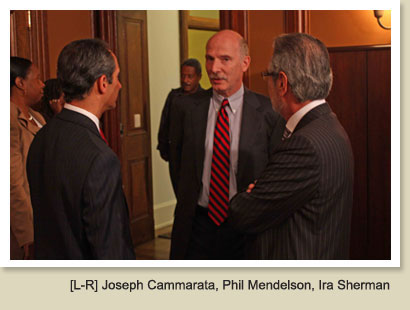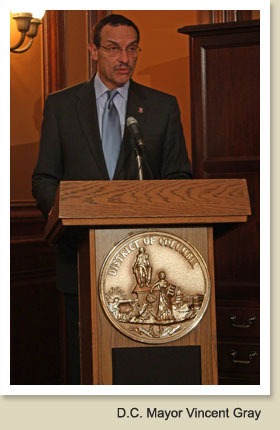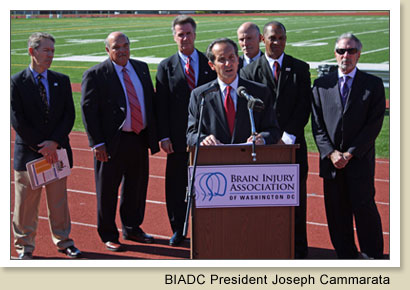D.C. Youth Athletic Concussion Protection Act
Serving Washington, D.C.


Athletic Concussion Protection Act and How it Protects Young Athletes

As students begin a new school year and prepare their return to a new season of sports, the Brain Injury Association of D.C. would like to remind everyone about the importance of making safety a priority - especially when it comes to protecting young athletes against the risks of concussions.
One way parents, coaches, and others involved in youth sports can prepare for the season ahead is to become acquainted with the DC Youth Athletic Concussion Protection Act, which was drafted by the President of the Brain Injury Association of D.C., Joseph Cammarata. The Act, which became law in 2011, is designed to protect youth athletes from the dangers of concussions, a form of traumatic brain injury that can have serious, long-term consequences, especially if they are not properly addressed and treated. Below is some important information about the Act.
Who is Covered by the Act?
The Act applies to youth athletes ages 18 and younger who participate in any sport or athletic activity at a public, private, or charter school, as well as youth leagues, in the District of Columbia.
Concussion Protocol
At the heart of the DC Youth Athletic Concussion Protection Act are rules coaches, trainers, and others must abide by when a young athlete is suspected of having suffered a concussion. The protocol consists of the following:
·Athletes suspected of sustaining a concussion during athletic activity must be immediately removed from practice or play.
·Athletes cannot return to physical participation unless they have been (1) evaluated by a licensed health care provider and (2) receive written clearance to return to activity.
Ultimately, this protocol can be summed up with the phrase: When in doubt, take them out! By removing an athlete from play and keeping them out until they are cleared to return, we can significantly reduce the risks of them suffering additional harm, including the long-term effects of chronic brain injury.
There are also various resources - including this concussion recognition app - that can help coaches and parents adhere to these procedures.
Training Program
The Act also implemented a training program to educate coaches, trainers, physical education teachers, and others involved in youth sports about concussions, risks, reporting rules, and proper procedures for removing and returning an athlete to play. Coaches and others required to participate in the program must present a certificate of completion to their school or organization and must renew their training every 2 years.
Learn more about HEADS UP online training.
Educational Materials
In addition to the training program, the Act helped prompt the development of educational materials about the nature and risk of concussions. These materials are distributed to young athletes and their parents.
The Brain Injury Association of D.C. is proud that President Cammarata was able to share his experience and insight when creating the DC Youth Athletic Concussion Protection Act and we are proud to offer our services and support to anyone who has questions about traumatic brain injuries and injuries that occurred during a youth athletic activity.
Press Release

FOR IMMEDIATE RELEASE (July 27, 2011)
District of Columbia’s Athletic Concussion Act
— The Most Comprehensive Law of its Kind
Brain Injury Association of D.C., Children’s National Medical Center,
National Football League, and the Washington Redskins
Applaud City Council’s Unanimous Passage and Mayor’s Signature of Landmark Legislation
Washington, D.C. – Landmark legislation developed to protect student-athletes in the nation’s capital from adverse effects of concussions was signed into law today. The legislation brings much needed protection to a particularly vulnerable segment of the population, and draws praise from local and national medical and sports organizations.
National research estimates about 400,000 concussions among high-school student-athletes from 2005 to 2008. The impact of a concussion on student-athletes are wide ranging, affecting their thinking and learning, as well as their social and emotional functioning.

The Athletic Concussion Protection Act of 2011, the new law in the District of Columbia, would apply to athletes 18 years old or younger. It would require them to be removed from practice or play following a suspected concussion, and would only allow them to return after written clearance by a licensed healthcare provider experienced in the evaluation and management of concussions. The Act also requires the Mayor to establish a training program, and directs the Department of Health to create educational materials on the nature and risks of concussions. Although similar legislation has been passed in 26 other states, the District’s law is the most comprehensive in its scope, addressing both in-school and extracurricular athletics.

“We have focused on the needs of the community’s most vulnerable population: youth athletes,” said Joseph Cammarata, President, Brain Injury Association of D.C. (BIADC), who initially identified the need for such a law in the District, and led the charge by drafting language, securing sponsorship within the City Council, and generating support within the community. “As the nation’s capital, we should serve as a leader and set the example for others to follow, and the breadth of this law shows we have done just that.”

Several local and national organizations joined BIADC in praising Mayor Vincent Gray and the City Council for swift passage of the measure. Championed by BIADC as the principal local organization focused on this issue, the legislation was also actively supported by Children’s National Medical Center, the National Football League (NFL) and the Washington Redskins.

“The NFL and Washington Redskins are proud and pleased to support the Athletic Concussion Protection Act of 2011,” said Brig Owens, former defensive back for the Redskins. “It will prevent avoidable brain injuries and make youth sports better by making them safer. Parents, coaches, teachers and school officials will certainly benefit from this new law. And, most importantly, so will kids throughout the District of Columbia. And, that’s a winning game plan.”

“National dialogue about this legislation has primarily focused upon the athletic responsibilities of the student-athlete. But we cannot ignore the consequences of a concussion on the academic learning and performance of the student-athlete,” said Gerard Gioia, PhD, Director, Safe Concussion Outcome Recovery & Education (SCORE) Program, Children’s National Medical Center. “Our current research finds adverse effects on school learning, with close to 90% of students in our clinics reporting significant worsening of post-concussion symptoms when they attempt cognitive tasks. In our experience, these problems persisted well beyond a month for many students. We must provide effective treatments that maximize the student’s recovery and minimize any long-term post-concussion problems.”

“The NFL is playing a leading role in addressing the issue of concussions for our players as well as athletes at all levels, and in all sports,” said Kenneth Edmonds, Director of Government Relations and Public Policy, NFL. “Our work with the Centers for Disease Control and Prevention and USA Football has disseminated vital information to youth athletes, coaches and parents across the country. In collaboration with leaders in medicine, education, sports, and government, the NFL also has undertaken a state-level advocacy effort to promote youth concussion laws similar to the 2009 Zackery Lystedt law in the state of Washington.”

The new law will take effect after a 30-day review period by the U.S. Congress, which is required of all laws enacted in the District, as well as official publication the District Register, which is the weekly official legal bulletin published by the District government.
For More Information:
Brain Injury Association of D.C.: http://www.biadc.org
Children’s National Medical Center, Safe Concussion Outcome Recovery & Education (SCORE) Program: http://www.childrensnational.org/score/
CONTACTS
Brain Injury Association of D.C.: |
Children’s National Medical Center: |
National Football League: |
Washington Redskins |
Copy of The Law


Announcement of the District of Columbia Athletic Concussion Protection Act of 2010. BIADC President Joseph Cammarata leads the presentation, introducing (background, L-R): Dr. Gerard Gioia, Children’s National Medical Center; Mark Meana, USA Football; Bruce Allen, Washington Redskins; Councilmember Phil Mendelson; Councilmember Harry Thomas; and Ira Sherman, BIADC.
On Monday, September 20, 2010, Councilmembers Phil Mendelson (At Large) and Harry Thomas (Ward 5) introduced a bill to protect student athletes in the District of Columbia from adverse health consequences of concussions. The Brain Injury Association of Washington, D.C. has been the lead advocate of this important legislation, and BIADC President Joseph Cammarata introduced the Councilmembers at the event. Also participating were the National Football League, the Washington Redskins, USA Football and Children’s National Medical Center.
According to recent research, concussions occur frequently in student athletes, with 400,000 known occurrences at the high school level from 2005 to 2008. The “Athletic Concussion Protection Act of 2010” would require a youth or disabled athlete to be removed from practice or play following a suspected concussion and only allowed to return after clearance by a licensed health care provider, and would also direct city agencies to develop an awareness and training program for coaches, athletic trainers, school personnel, athletes, parents and guardians. This legislation is modeled on the Zackery Lystedt Law introduced in Washington state, and since enacted in Connecticut, Idaho, Massachusetts, New Mexico, Oklahoma, Oregon, Rhode Island and Virginia. The NFL has strongly advocated its passage in all states.
Media links:

Brain Injury Association of Washington, D.C. (BIADC)






